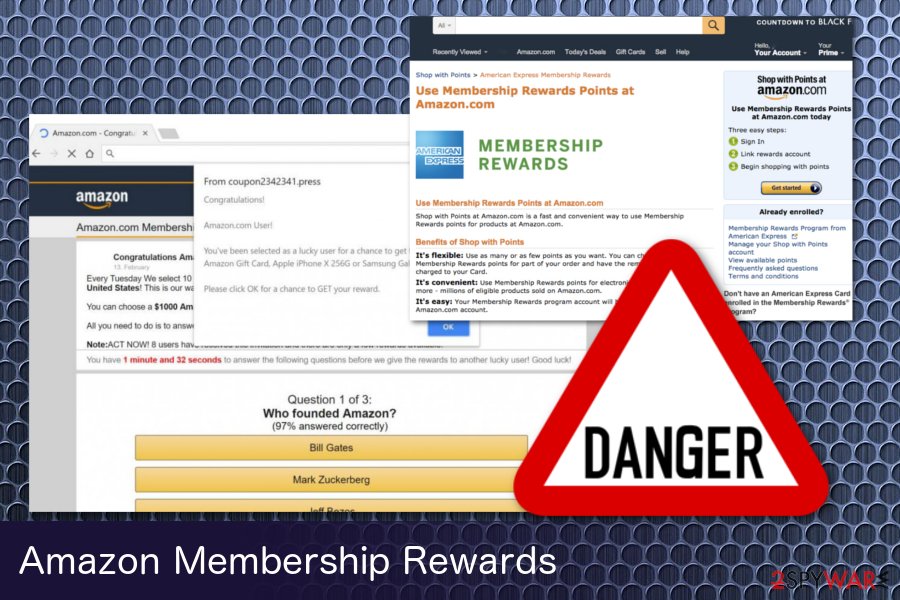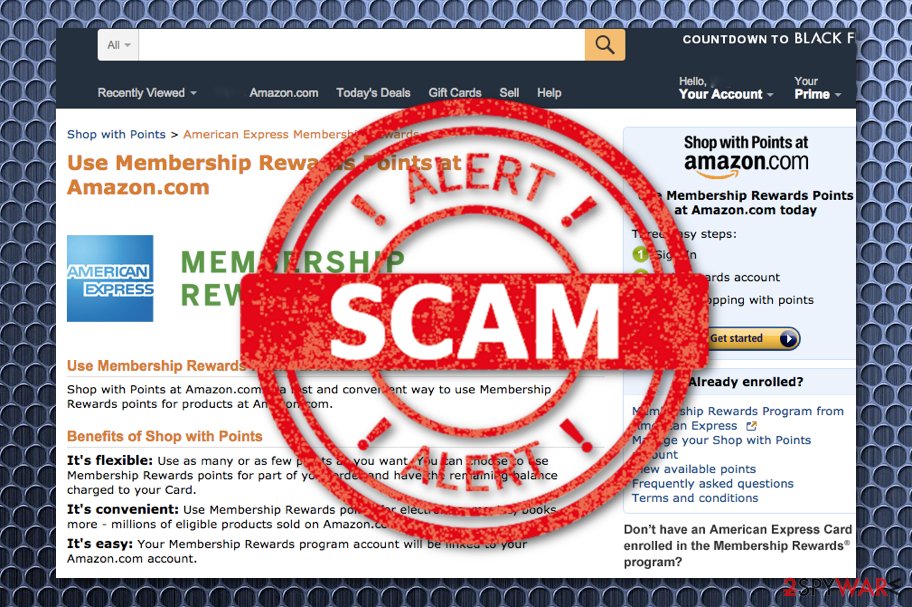“Amazon.com Membership Rewards” scam (Jun 2021 update) - virus
“Amazon.com Membership Rewards” scam Removal Guide
What is “Amazon.com Membership Rewards” scam?
Amazon Membership Rewards is a cyber infection that is designed to steal sensitive data

Amazon Membership Rewards virus is an online scam which is similar to Congratulations Amazon User and Amazon Membership Rewards hoaxes. The purpose of this cyber threat is to trick people into filling a fake survey, and in this way, revealing personal information. Scammers use the name of a popular company and claims that the victim was selected as the applicant to win valuable prizes.[1] However, these pop-ups are fake and created by adware. Therefore, instead of filling out dubious questionnaires, you should check the system for potentially unwanted programs (PUPs) or malware. Completing these surveys and revealing your email or other personal information to cyber criminals might end up with serious privacy-related issues.
| Name | Amazon.com Membership Rewards |
|---|---|
| Type | Scam |
| Caused by | Adware |
| Domain name | coupon2342341.com (can also be changed to another one) |
| Affected web browsers | Google Chrome, Internet Explorer, Safari, Mozilla Firefox, Opera |
| Elimination | To get rid of such scams, you need to uninstall adware from your system – either do it manually or automatically (we provide the instructions below) |
| System fix | When you get rid of adware/malware, system main remain unstable. To fix virus damage, scan your computer with FortectIntego |
The only option available on the Amazon Membership Awards alert is the OK button. Once clicked, it redirects the user of Chrome, Firefox, IE or another web browser to a fake questionnaire that, seeking to mislead its victims, relies on the same font and colors as the ones used by this giant company.
In most of the cases, Amazon Winner virus shows up on the pop-up using coupon2342341.com. On the initial pop-up window, a victim is presented a small box with OK button. Unfortunately, this pop-up will not go away unless people click the OK button because it freezes the browser and allows the user to navigate only in one direction – to answer the questionnaire.
Apart from delivering fake lottery pop-ups and forcing people to fill surveys, adware might also provide other ads, banners or pop-ups, for example:
- your system is in danger;
- your PC is infected;
- warning about pornographic or malicious websites;
- fake winning pop-ups;
- virus detected warning;
- random, questionable rewards;
- shopping offers or deals.

No matter how much you trust Amazon, do not fall for this trick. The platform does not offer to win 1000 USD for answering several questions. The Amazon.com/Membership Rewards spam is not real and is employed by scammers seeking to swindle people's personal details, like the name, email address, telephone number, and other personal information. Such information can be misused for various shady activities, such as phone scam or malspam.[2] Also, by adding your details to this questionnaire, you may subscribe for an unknown service and notice unfamiliar payments in your telephone bill every month.
Therefore, although this pop-up does not cause direct harm to your PC and your privacy, it can ruin your web browsing experience and extort personal information out of you. Therefore, you should remove Amazon Membership Rewards popup without delay because it is not legit or real. In this case, you need to find an ad-supported add-on which is hiding in your system. Typically, they infiltrate computers as additional components of free software.
 Th threat removal is essential not only for restoring normal web browser's performance, but also for protecting privacy
Th threat removal is essential not only for restoring normal web browser's performance, but also for protecting privacy
As a result, virus removal might be difficult to perform. That's because it's not clear what software has to be eliminated from the system to disable these ads. However, you should always check your recently-installed programs on Task Manager (you can list them by date) and pay attention to their developers. Ones that do not provide the developer should be considered as potentially malicious.
Therefore, the easiest way to terminate ads like “www.amazon.com/membershiprewards to complete your registration” is to run a full system scan with security software. If you want to ensure that your computer is fixed and malware elimination complete, scan it with SpyHunter 5Combo Cleaner, Malwarebytes.
Incorrect installation of freeware might end up with adware infiltration
Adware-type programs spread by bundling. That's a fact. Millions of people end up installing software bundles without being aware of that. The reason for this is nothing else but lack of knowledge about cybersecurity.
Those who seek to keep the system protected from malware like adware and browser hijacker has to remember that they are disseminated as attachments of free programs, most of which exhibit a rather high rate of downloads per day. The installation of such applications by hitting the Next button all the time widely opens the door for potentially unwanted programs to enter your PC's system.
To prevent this from happening, experts[3] recommend selecting Advanced and Custom installation method all the time. Although such installation is a little bit longer if compared to Quick or Basic, it will disclose windows with additional installers and provide the possibility to opt out of them.

Remove Amazon Rewards scam and adware-related components from the system
If you have been wondering is the rewards a hoax, our answer is yes. You need to get rid of programs that are responsible for showing this alert on your computer without a delay because they can also be used for tracking you and collecting non-personal information. In addition, adware that triggers this scam can also fill your browser with pop-up and banner ads, create interstitials, and even cause redirects to malicious websites.
To prevent such and similar activities, you need to remove Amazon Membership Rewards hoax. As we have already mentioned, you have two options to do that properly. If you prefer fixing your system manually, check the step-by-step the removal guide. Nevertheless, we strongly recommend deleting this adware program with a professional malware removal tool to remove other malware that might be installed at the same time and eliminate broken registry keys.
You may remove virus damage with a help of FortectIntego. SpyHunter 5Combo Cleaner and Malwarebytes are recommended to detect potentially unwanted programs and viruses with all their files and registry entries that are related to them.
Getting rid of “Amazon.com Membership Rewards” scam. Follow these steps
Uninstall from Windows
Instructions for Windows 10/8 machines:
- Enter Control Panel into Windows search box and hit Enter or click on the search result.
- Under Programs, select Uninstall a program.

- From the list, find the entry of the suspicious program.
- Right-click on the application and select Uninstall.
- If User Account Control shows up, click Yes.
- Wait till uninstallation process is complete and click OK.

If you are Windows 7/XP user, proceed with the following instructions:
- Click on Windows Start > Control Panel located on the right pane (if you are Windows XP user, click on Add/Remove Programs).
- In Control Panel, select Programs > Uninstall a program.

- Pick the unwanted application by clicking on it once.
- At the top, click Uninstall/Change.
- In the confirmation prompt, pick Yes.
- Click OK once the removal process is finished.
Delete from macOS
Remove items from Applications folder:
- From the menu bar, select Go > Applications.
- In the Applications folder, look for all related entries.
- Click on the app and drag it to Trash (or right-click and pick Move to Trash)

To fully remove an unwanted app, you need to access Application Support, LaunchAgents, and LaunchDaemons folders and delete relevant files:
- Select Go > Go to Folder.
- Enter /Library/Application Support and click Go or press Enter.
- In the Application Support folder, look for any dubious entries and then delete them.
- Now enter /Library/LaunchAgents and /Library/LaunchDaemons folders the same way and terminate all the related .plist files.

Remove from Microsoft Edge
Delete unwanted extensions from MS Edge:
- Select Menu (three horizontal dots at the top-right of the browser window) and pick Extensions.
- From the list, pick the extension and click on the Gear icon.
- Click on Uninstall at the bottom.

Clear cookies and other browser data:
- Click on the Menu (three horizontal dots at the top-right of the browser window) and select Privacy & security.
- Under Clear browsing data, pick Choose what to clear.
- Select everything (apart from passwords, although you might want to include Media licenses as well, if applicable) and click on Clear.

Restore new tab and homepage settings:
- Click the menu icon and choose Settings.
- Then find On startup section.
- Click Disable if you found any suspicious domain.
Reset MS Edge if the above steps did not work:
- Press on Ctrl + Shift + Esc to open Task Manager.
- Click on More details arrow at the bottom of the window.
- Select Details tab.
- Now scroll down and locate every entry with Microsoft Edge name in it. Right-click on each of them and select End Task to stop MS Edge from running.

If this solution failed to help you, you need to use an advanced Edge reset method. Note that you need to backup your data before proceeding.
- Find the following folder on your computer: C:\\Users\\%username%\\AppData\\Local\\Packages\\Microsoft.MicrosoftEdge_8wekyb3d8bbwe.
- Press Ctrl + A on your keyboard to select all folders.
- Right-click on them and pick Delete

- Now right-click on the Start button and pick Windows PowerShell (Admin).
- When the new window opens, copy and paste the following command, and then press Enter:
Get-AppXPackage -AllUsers -Name Microsoft.MicrosoftEdge | Foreach {Add-AppxPackage -DisableDevelopmentMode -Register “$($_.InstallLocation)\\AppXManifest.xml” -Verbose

Instructions for Chromium-based Edge
Delete extensions from MS Edge (Chromium):
- Open Edge and click select Settings > Extensions.
- Delete unwanted extensions by clicking Remove.

Clear cache and site data:
- Click on Menu and go to Settings.
- Select Privacy, search and services.
- Under Clear browsing data, pick Choose what to clear.
- Under Time range, pick All time.
- Select Clear now.

Reset Chromium-based MS Edge:
- Click on Menu and select Settings.
- On the left side, pick Reset settings.
- Select Restore settings to their default values.
- Confirm with Reset.

Remove from Mozilla Firefox (FF)
Remove dangerous extensions:
- Open Mozilla Firefox browser and click on the Menu (three horizontal lines at the top-right of the window).
- Select Add-ons.
- In here, select unwanted plugin and click Remove.

Reset the homepage:
- Click three horizontal lines at the top right corner to open the menu.
- Choose Options.
- Under Home options, enter your preferred site that will open every time you newly open the Mozilla Firefox.
Clear cookies and site data:
- Click Menu and pick Settings.
- Go to Privacy & Security section.
- Scroll down to locate Cookies and Site Data.
- Click on Clear Data…
- Select Cookies and Site Data, as well as Cached Web Content and press Clear.

Reset Mozilla Firefox
If clearing the browser as explained above did not help, reset Mozilla Firefox:
- Open Mozilla Firefox browser and click the Menu.
- Go to Help and then choose Troubleshooting Information.

- Under Give Firefox a tune up section, click on Refresh Firefox…
- Once the pop-up shows up, confirm the action by pressing on Refresh Firefox.

Remove from Google Chrome
Delete malicious extensions from Google Chrome:
- Open Google Chrome, click on the Menu (three vertical dots at the top-right corner) and select More tools > Extensions.
- In the newly opened window, you will see all the installed extensions. Uninstall all the suspicious plugins that might be related to the unwanted program by clicking Remove.

Clear cache and web data from Chrome:
- Click on Menu and pick Settings.
- Under Privacy and security, select Clear browsing data.
- Select Browsing history, Cookies and other site data, as well as Cached images and files.
- Click Clear data.

Change your homepage:
- Click menu and choose Settings.
- Look for a suspicious site in the On startup section.
- Click on Open a specific or set of pages and click on three dots to find the Remove option.
Reset Google Chrome:
If the previous methods did not help you, reset Google Chrome to eliminate all the unwanted components:
- Click on Menu and select Settings.
- In the Settings, scroll down and click Advanced.
- Scroll down and locate Reset and clean up section.
- Now click Restore settings to their original defaults.
- Confirm with Reset settings.

Delete from Safari
Remove unwanted extensions from Safari:
- Click Safari > Preferences…
- In the new window, pick Extensions.
- Select the unwanted extension and select Uninstall.

Clear cookies and other website data from Safari:
- Click Safari > Clear History…
- From the drop-down menu under Clear, pick all history.
- Confirm with Clear History.

Reset Safari if the above-mentioned steps did not help you:
- Click Safari > Preferences…
- Go to Advanced tab.
- Tick the Show Develop menu in menu bar.
- From the menu bar, click Develop, and then select Empty Caches.

After uninstalling this potentially unwanted program (PUP) and fixing each of your web browsers, we recommend you to scan your PC system with a reputable anti-spyware. This will help you to get rid of “Amazon.com Membership Rewards” scam registry traces and will also identify related parasites or possible malware infections on your computer. For that you can use our top-rated malware remover: FortectIntego, SpyHunter 5Combo Cleaner or Malwarebytes.
How to prevent from getting adware
Stream videos without limitations, no matter where you are
There are multiple parties that could find out almost anything about you by checking your online activity. While this is highly unlikely, advertisers and tech companies are constantly tracking you online. The first step to privacy should be a secure browser that focuses on tracker reduction to a minimum.
Even if you employ a secure browser, you will not be able to access websites that are restricted due to local government laws or other reasons. In other words, you may not be able to stream Disney+ or US-based Netflix in some countries. To bypass these restrictions, you can employ a powerful Private Internet Access VPN, which provides dedicated servers for torrenting and streaming, not slowing you down in the process.
Data backups are important – recover your lost files
Ransomware is one of the biggest threats to personal data. Once it is executed on a machine, it launches a sophisticated encryption algorithm that locks all your files, although it does not destroy them. The most common misconception is that anti-malware software can return files to their previous states. This is not true, however, and data remains locked after the malicious payload is deleted.
While regular data backups are the only secure method to recover your files after a ransomware attack, tools such as Data Recovery Pro can also be effective and restore at least some of your lost data.
- ^ Brett M. Christensen. No, Amazon is NOT Giving Everyone a Free $100 Coupon. Hoax-Slayer. Cyber security news blog.
- ^ Bradley Barth. Malspam campaign delivers LokiBot by abusing Windows Installer. SC Media. Offers in-depth features and timely news, and independent product reviews.
- ^ SenzaVirus. SenzaVirus. Virus and Spyware news.
